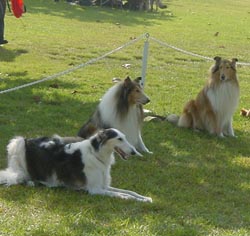Ever
since wolf cubs were first adopted
by humans, humans have been trying
to communicate with the canine species.
Dogs have learned to
understand human
whistles, words, hand signals,
facial expressions,
intentional, and even
unintentional, body language.
Vocabulary
 To
simplify the communication process,
we humans have learned that
dogs can quickly learn what
specific human sounds mean in any
language. If the sound is repeatedly
associated with a clear
physical cue, the
dog learns to associate the
two. This is the basis of
teaching the dog to sit,
come, stay, etc.
To
simplify the communication process,
we humans have learned that
dogs can quickly learn what
specific human sounds mean in any
language. If the sound is repeatedly
associated with a clear
physical cue, the
dog learns to associate the
two. This is the basis of
teaching the dog to sit,
come, stay, etc.

No
threats.
 Ideally,
communication between dog and
person
is understood without
threat.
Ideally,
communication between dog and
person
is understood without
threat.
No
scolding. Unfortunately,
dogs do not
always understand and follow the human's
cue,
and the human often resorts
to yelling or punishment.
No
confusion. In
some cases, the owner has never fully established
a positive leadership role,
and therefore the dog does not
recognize the human as having
the authority to give
instruction. Far more often,
the human had not taken the
time to sufficiently teach the
dog the meaning of the verbal
cue in different situations.
Clear message.
Finally, in some cases, the
dog simply did not understand
the person due to confusing
voice tone or body language. For example, to
the dog, the word come
is a
very different sound than, "Here
boy, come 'ere now." Humans
may learn the same meaning comes from many sounds, but the
dog is trying to learn to recognize
the sound itself.
|
When the dog
sees the postman and begins
to bark, quickly change the
tone and volume to an
instructive reprimand using
the word, "QUIET!"
|
Voice tone.
The
best way to give a verbal cue is in a calm, neutral
voice with a relaxed but firm body posture
that communicates a positive
expectation that the dog will perform the requested task.
Instructive
Reprimand
 If
the dog does not
respond as
expected, scolding most likely
confuses the dog and decreases the
bond between person and pet.
Do not repeat the Instruction in a louder
and more threatening tone.
If the dog is confused, the
threat only adds anxiety not
learning.
If
the dog does not
respond as
expected, scolding most likely
confuses the dog and decreases the
bond between person and pet.
Do not repeat the Instruction in a louder
and more threatening tone.
If the dog is confused, the
threat only adds anxiety not
learning.
Tell the
dog what TO do not what NOT to
do. For example, chewing wrong
things and excessive
barking are two commonly
perceived crimes committed by dogs.
Useful instructive
reprimands are, "OFF"
(back off from that object) or
"LEAVE IT" (stop touching what you are
now touching) or "DROP"
(release that object from your
mouth) and "QUIET."
In this context the owner wants
the dog to STOP doing something.
If the owner simply yells "NO,"
the dog knows there is potential
punishment, but might not know
what to do to avoid that punishment.
Instead of NO, the instruction
is more clear when one says "QUIET"
or "OFF" to help
the dog
better understand how to
comply with the request and
avoid punishment.
Instructive
Praise
Positive Reinforcement.
Instructive
praise helps the dog associate the
verbal cue with the behavior in a positive context.
Verbal praise is much
better than human silence after
the dog complies with a
request or instruction.
If
the dog does respond
to an instruction,
immediate praise
helps the dog to learn
what is right.
Praise is appreciated by
most dogs when it is given
selectively and not randomly. Praise can
be
instructive
as well
if using a praise tone. If the dog sits on
cue,
instead of "Good Dog,"
say, "Good Sit."
 Prevention.
One
of the most useful aspects of
instructive praise is preventing
an anticipated unwanted
behavior. If excessive barking
is anticipated, the cue, quiet,
instructs the dog to
prevent unwanted
barking. For
example, if you see the postman
coming before the dog sees him,
begin to praise, "Good
Quiet" repeatedly. If
the dog knows the meaning of
"Quiet",
this pre-emptive instruction may prevent
barking as the dog is enjoying
the praise.
Prevention.
One
of the most useful aspects of
instructive praise is preventing
an anticipated unwanted
behavior. If excessive barking
is anticipated, the cue, quiet,
instructs the dog to
prevent unwanted
barking. For
example, if you see the postman
coming before the dog sees him,
begin to praise, "Good
Quiet" repeatedly. If
the dog knows the meaning of
"Quiet",
this pre-emptive instruction may prevent
barking as the dog is enjoying
the praise. If
the dog sees the postman
and begins to bark, by quickly
changing the tone to an
instruction by using the same
word, "QUIET," gives the canine
a clear contrast.
If
the dog sees the postman
and begins to bark, by quickly
changing the tone to an
instruction by using the same
word, "QUIET," gives the canine
a clear contrast.
The dog will
understand more clearly what you
want when
instructive praise
turns to an instructive
reprimand. It may be useful to
use a new sound interruption
such as "Ah-Ah"
to
interrupt the dog
and then give an
instruction that you
know your dog will do
for praise.
When
you change your thinking
about your pet,
and apply new training methods,
you communicate more clearly. Your pet responds with love, respect and good behavior.